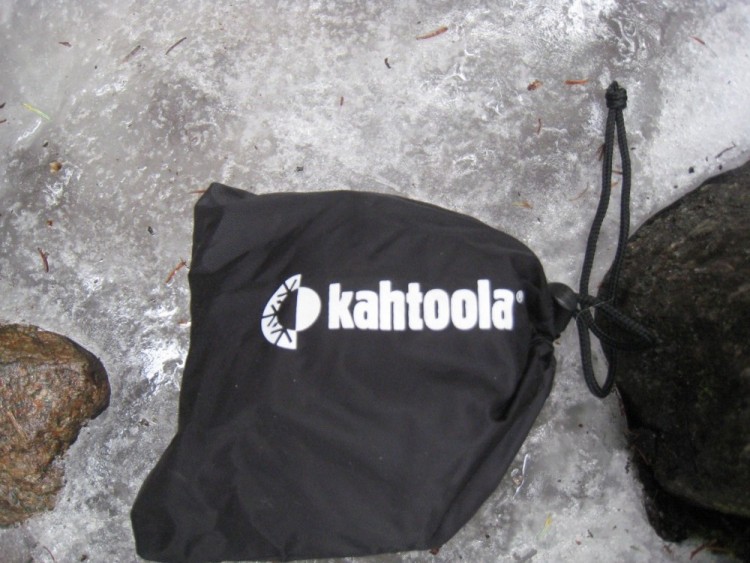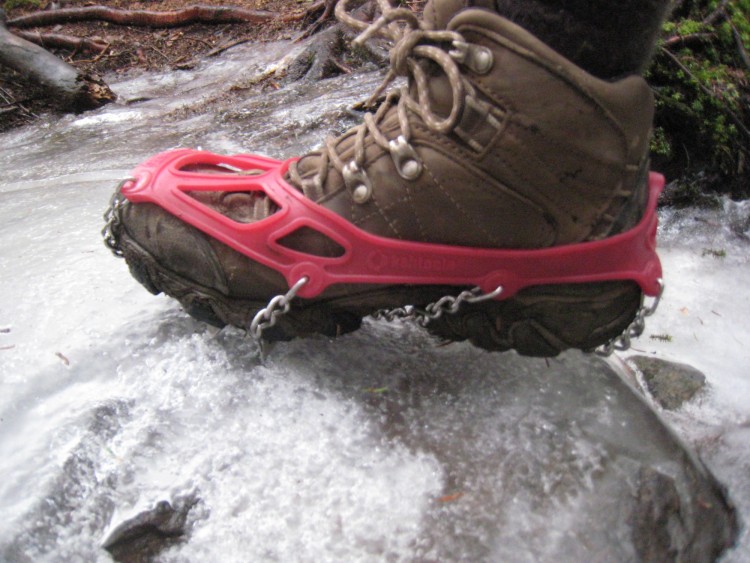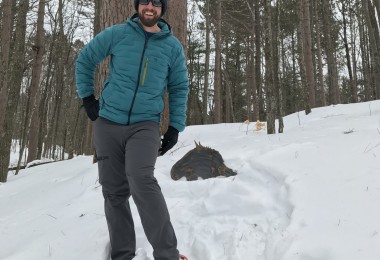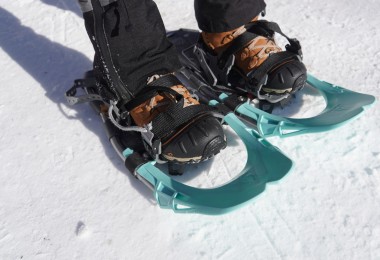Nightmarish icy hikes: we’ve all been there. You’re on a late fall hike or early spring hike up a mountain. The trail conditions were fine at the bottom, but as you get closer to the top, the path is covered in ice. Each step forward slows as you struggle to keep your footing, pulling yourself up with your poles. You reach the top by raw tenacity and then slowly slide your way back down the trail. You take a few spills on the way down and are in the woods hours later than intended.
A few years ago, that familiar account applied to almost every fall hike that I went on. Poles helped, but it wasn’t until I got a pair of MICROspikes that I realized what I’d been missing. The stainless steel Kahtoola MICROspikes stretch over boots with an elastomer harness, providing an excellent traction system on ice and compacted snow.
Some of the links in this article may contain affiliate links. When you make a purchase using these links, part of the proceeds go to Snowshoe Mag. Additionally, as an Amazon Associate, we earn from qualifying purchases. Please see our disclosure for more details.
Initial Impressions & Specs
Out of the box, I was really impressed with my Kahtoola MICROspikes. Unlike the first pair I owned, the MICROspikes come in a lightweight, black stuff sack. I know more than a few people who bought a bottle of Crown Royal (purportedly) to get a bag for their MICROspikes. Don’t fear, whiskey fans. I’m sure you can find something else that really needs a bag.
Packaging aside, I was also really pleased about the weight and the bulk of the MICROspikes. They come in sizes small to x-large and weigh between 11.0 oz and 13.5 oz per pair, depending on the size.
The elastomer harness that stretches over the boots appears to be compact, lighter, and easier to stretch.

Kahtoola microspikes in their tote, a handy alternative to the Crown Royal bag. Photo: Chrissy Raudonis
In the Field
I got a chance to take my Kahtoola MICROspikes out for a hike up Mt. Algonquin in the Adirondacks. The trail provided a perfect set of test conditions. At the start of the hike, the trail was clear of snow and ice, but as I gained elevation, the water running down the trail slowly started to freeze. I finally put the spikes on at the bottom of a large, icy boulder that the trail went over.
The Grip on Wet Ice
The MICROspikes did a great job of gripping the wet ice. At this point, the spikes were more for security than anything else. I could have traveled pretty quickly without them, but they greatly reduced my risk of slipping.
About a half-mile after putting them on, the trail became completely covered in ice as the grade increased. With little to no snow for improved traction, I was basically walking on ice the last mile to the summit. The ice got progressively harder and slicker as I ascended. Getting to the top would have been impossible without MICROspikes or some other form of added traction. At the windy, inhospitable summit, I ran into a group of four backpackers, also all wearing Kahtoola MICROspikes.
On flat terrain, the Kahtoola MICROspikes traction system was exceptional as well. I know people who use them for jogging on ice. I found that the spikes worked great during my hike when I planted them on flat ice after jumping down rocks.
Read More: Kahtoola MICROspikes: A Runner’s Perspective
The Grip on Steep Slopes
As the grade increased, however, they become less reliable, and my trip up Algonquin was definitely pushing the limits of the traction that they are designed to provide. I had to ensure that the spikes were digging in well before I committed to a foot-hold in certain very steep spots. Generally, I got better traction when placing my feet perpendicular to the slope rather than turning them to the side.
The spikes did slip several times during the course of the hike – always on a steep incline. Overall, they performed slightly better than my old pair, traction-wise. The MICROspikes include 12 stainless steel spiles that are 3/8 inches each for traction.
Both pairs of MICROspikes that I’ve owned I consider to be a tool similar to trekking poles. They will help to keep me from sliding, but I can’t completely rely on them under all conditions.
However, if you are regularly going on steep-grade hikes, you could use Kahtoola’s K10 Hiking Crampons as an alternative to the MICROspikes.
Read More: How to Choose the Best Trail: Tips for Learning When You Need Snowshoes

The bottom of the microspikes is a combination of metal chains and points that flexibly provide traction. Plus, no snow build-up. Photo: Chrissy Raudonis
Snow Build-Up
My old pair of MICROspikes would sometimes become overloaded with snow, and I would have to take measures to clean them. However, now, the MICROspikes fared far better.
When the trail was covered with a mixture of ice, snow, and running water at lower elevations, the spikes accumulated a small amount of slush, which they eventually shed on their own.
The Harness
One of my pet-peeves with my last pair of MICROspikes was that the harness would frequently slip to the side when I was hiking. The spikes would become misaligned, and I would have to stop and reposition the harness. With my new pair, the harness didn’t slip on my boots at all.
The harness is a durable TPE intended for a secure fit while also remaining maneuverable until temperatures down to -22 F (-30 C).
The MICROspikes are also extremely easy to change into, taking only about 15 seconds for me to put on and 10 to take off.
Read More: Snowshoeing Footwear: Tips for Choosing Your Boot

The Microspikes in action – getting to the summit would have been difficult without them. However, be cautious of using them for very steep slopes. Photo: Chrissy Raudonis
Ideal Use
Over the past few years, I’ve found MICROspikes to be useful under various weather conditions, including walking on slick, packed trails, traveling on trails that have undergone several cycles of thaws and freezes, and exploring frozen lakes. Some hikers carry both MICROspikes and snowshoes and switch to the MICROspikes on icy, rocky sections to save their crampons from being worn down.
Like any piece of equipment, the Kahtoola MICROspike traction system has its limitations. However, the fact that they are lightweight, have the ease of donning and doffing, and provide traction for most icy conditions make them a great deal at $69.95 MSRP.
The MICROspikes also come with a 2-year warranty against manufacturer defects, and I have a feeling that I’ll be getting many miles to come out of my pair. You can purchase the Kahtoola MICROspikes at REI, Amazon, or Kahtoola.com.
Have you used a traction system such as Kahtoola MICROspikes? What was your experience? Please share with us in the comments below.
This article was originally published on Jan 8, 2016, and was updated by Susan Wowk to include new information on Dec 12, 2021.
Read Next:
Kahtoola NAVAgaiter Review: A Gaiter for Any Terrain
Yaktrax Reviews: The Ascent & Summit for Slippery Climbs
Definitive Guide: How to Choose the Perfect Snowshoes for Your Needs
What to Bring When Snowshoeing: Top Accessories for the Day Hiker








Leave a Comment